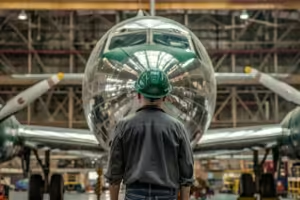In the fast-paced world of aviation, maintaining high standards is crucial for ensuring safety, efficiency, and reliability.
Among the many standards that guide the industry, ARINC 625 plays a significant role. But what exactly is ARINC 625, and why is it so important?
ARINC 625 is a standard developed to streamline and enhance various aspects of aviation operations, from maintenance procedures to communication protocols.
Its comprehensive guidelines help aviation professionals maintain consistency, improve operational efficiency, and ensure the highest levels of safety.
In this blog, we’ll explore what ARINC 625 is all about, its key features, and how it is applied in real-world aviation scenarios.
By understanding this standard, we can appreciate its impact on the industry and its role in shaping the future of aviation.
What is ARINC 625?
ARINC 625 is a technical standard developed by Aeronautical Radio, Inc. (ARINC), a key organization that creates standards for aviation electronics and communication.
This standard is specifically designed to provide comprehensive guidelines for the maintenance, overhaul, and repair of aircraft and their components.
At its core, ARINC 625 aims to ensure consistency, safety, and efficiency in aviation maintenance operations.
It outlines detailed procedures and requirements that aviation professionals must follow to maintain the highest standards of aircraft reliability and safety.
By adhering to ARINC 625, airlines and maintenance organizations can streamline their processes, reduce errors, and enhance the overall quality of their operations.

Key Components of ARINC 625:
Maintenance Procedures: ARINC 625 provides standardized methods for performing various maintenance tasks. These procedures cover everything from routine inspections to complex repairs, ensuring that all maintenance activities are carried out uniformly and effectively.
Documentation Requirements: The standard includes specific guidelines for documenting maintenance activities. This ensures that all work performed on an aircraft is recorded accurately, providing a clear maintenance history and facilitating easier audits and inspections.
Training and Certification: ARINC 625 outlines the necessary training and certification requirements for maintenance personnel. This ensures that technicians and engineers possess the necessary skills and knowledge to perform their duties safely and effectively.
Quality Assurance: The standard emphasizes the importance of quality assurance in maintenance operations. It includes guidelines for conducting quality checks and audits to ensure that all maintenance activities meet the required standards and specifications.
Safety Protocols: Safety is a top priority in aviation, and ARINC 625 includes comprehensive safety protocols to protect both maintenance personnel and the aircraft. These protocols cover everything from the safe handling of hazardous materials to the proper use of tools and equipment.
Real-World Applications of ARINC 625
ARINC 625 plays a crucial role in the aviation industry, guiding the maintenance and operational practices of aircraft and their components.
Its comprehensive standards are applied across various aspects of aviation to enhance safety, efficiency, and reliability. Here are some real-world applications of ARINC 625:
1. Aircraft Maintenance and Overhaul
ARINC 625 provides standardized procedures for routine and non-routine maintenance tasks, ensuring consistency and quality in aircraft upkeep.
Airlines and maintenance organizations rely on these guidelines to conduct regular inspections, diagnose issues, and perform necessary repairs and overhauls.
By following ARINC 625 standards, maintenance teams can ensure that every aircraft meets the highest safety and performance standards, reducing the risk of malfunctions and improving operational reliability.
Case Study: A major airline implemented ARINC 625 standards across its maintenance facilities, resulting in a significant reduction in aircraft downtime and an increase in on-time departures.
By standardizing maintenance procedures, the airline ensured that every technician followed the same protocols, leading to more efficient and effective maintenance operations.

2. Component Repair and Certification
ARINC 625 extends beyond the aircraft itself, covering the maintenance and repair of individual components such as engines, avionics, and landing gear.
These standards provide detailed guidelines for disassembling, inspecting, repairing, and reassembling components, ensuring they meet stringent safety and performance criteria before being reinstalled on an aircraft.
Example: A leading aircraft engine manufacturer uses ARINC 625 standards to guide the repair and overhaul of its engines. By adhering to these guidelines, the company ensures that each engine is thoroughly inspected and tested, maintaining high levels of performance and reliability. This approach has led to fewer in-service failures and higher customer satisfaction.

3. Documentation and Record-Keeping
Accurate documentation is essential in aviation maintenance. ARINC 625 outlines specific requirements for recording maintenance activities, and creating a comprehensive maintenance history for each aircraft.
This documentation is crucial for tracking the performance and reliability of aircraft and components over time, facilitating audits, inspections, and regulatory compliance.
Example: An aviation maintenance organization implemented ARINC 625’s documentation standards to improve its record-keeping practices. The organization developed a centralized digital system for recording all maintenance activities, ensuring that every task was documented accurately and accessible for future reference. This system improved transparency, streamlined regulatory compliance, and enhanced the organization’s ability to track and analyze maintenance data.
4. Training and Certification of Maintenance Personnel
ARINC 625 includes guidelines for the training and certification of maintenance technicians and engineers.
By ensuring that all personnel are properly trained and certified, aviation organizations can maintain high standards of safety and efficiency in their maintenance operations.
Example: A maintenance training academy adopted ARINC 625 standards to develop its training programs. The academy’s curriculum includes comprehensive courses on the standard’s procedures and protocols, ensuring that graduates are well-prepared to perform maintenance tasks according to industry standards. As a result, the academy’s graduates are in high demand, known for their expertise and adherence to best practices.
5. Quality Assurance and Safety Protocols
Quality assurance is a critical component of ARINC 625. The standard provides guidelines for conducting quality checks and audits to ensure that all maintenance activities meet required specifications.
It also includes safety protocols to protect maintenance personnel and ensure safe operations.
How ARINC 625 Enhances Aviation Operations
ARINC 625 is a cornerstone in the aviation industry, providing a comprehensive framework that significantly enhances various aspects of aviation operations.
Its impact is seen in the streamlined maintenance processes, improved safety protocols, and elevated operational efficiency.
Here’s how ARINC 625 contributes to the enhancement of aviation operations:
1. Standardization of Maintenance Procedures
One of the primary ways ARINC 625 enhances aviation operations is through the standardization of maintenance procedures.
By providing a set of consistent guidelines for performing maintenance tasks, ARINC 625 ensures that all technicians follow the same protocols.
This uniformity reduces variability and potential errors, leading to more reliable maintenance outcomes.
Impact:
- Consistency: Every maintenance task is performed in the same manner, regardless of who carries it out or where it is performed.
- Efficiency: Standardized procedures streamline maintenance processes, reducing the time and effort required to perform routine and complex tasks.
2. Improved Safety and Reliability
Safety is paramount in aviation, and ARINC 625 plays a crucial role in enhancing safety measures across the industry.
The standard includes detailed safety protocols that must be followed during maintenance operations, from handling hazardous materials to ensuring the proper use of tools and equipment.
Impact:
- Risk Reduction: By adhering to ARINC 625 safety guidelines, maintenance personnel can minimize the risk of accidents and injuries.
- Reliability: Consistent application of these safety protocols ensures that aircraft and their components are maintained to the highest standards, enhancing overall reliability.
3. Enhanced Documentation and Record-Keeping
ARINC 625 provides comprehensive guidelines for documenting maintenance activities.
Accurate and detailed record-keeping is essential for tracking the history and performance of aircraft and their components, facilitating better decision-making and regulatory compliance.
Impact:
- Transparency: Detailed maintenance records offer clear insight into the history and status of each aircraft, making it easier to track issues and plan future maintenance.
- Compliance: Thorough documentation helps aviation organizations comply with regulatory requirements, avoiding potential legal and operational issues.
4. Optimized Training and Certification
ARINC 625 includes specific requirements for the training and certification of maintenance personnel.
By ensuring that technicians and engineers are properly trained, the standard helps maintain high levels of competence and expertise within the industry.
Impact:
- Skill Enhancement: Maintenance personnel receive comprehensive training, equipping them with the skills and knowledge needed to perform their duties effectively.
- Certification: Adhering to certification guidelines ensures that only qualified individuals carry out maintenance tasks, enhancing overall operational safety and efficiency.
5. Quality Assurance and Continuous Improvement
Quality assurance is a key component of ARINC 625. The standard outlines procedures for conducting regular quality checks and audits, ensuring that all maintenance activities meet established standards and specifications.
Impact:
- Quality Control: Regular audits and inspections help identify and address issues before they become significant problems, maintaining high-quality maintenance standards.
- Continuous Improvement: By systematically reviewing maintenance practices, organizations can continuously improve their processes and procedures, leading to better operational outcomes.
6. Facilitation of Technological Integration
ARINC 625 also facilitates the integration of new technologies and innovations into aviation maintenance practices.
The standard’s comprehensive framework can be adapted to incorporate advanced tools and techniques, ensuring that maintenance operations remain cutting-edge.
Impact:
- Innovation: By providing a flexible framework, ARINC 625 allows for the adoption of new technologies that can enhance maintenance efficiency and effectiveness.
- Future-Readiness: The ability to integrate emerging technologies ensures that aviation operations can evolve and adapt to future challenges and opportunities.
Conclusion
ARINC 625 stands as a vital standard in the aviation industry, ensuring that maintenance operations are conducted with the utmost precision, safety, and efficiency.
By standardizing procedures, enhancing safety protocols, and improving documentation practices, ARINC 625 helps aviation organizations maintain the highest levels of operational reliability and safety.
This comprehensive framework not only streamlines maintenance tasks but also fosters continuous improvement and innovation within the industry.
Incorporating ARINC 625 into aviation operations leads to more consistent, efficient, and safe maintenance practices, ultimately enhancing the overall performance and reliability of aircraft.
As the aviation industry continues to evolve, ARINC 625 remains a crucial tool in maintaining and advancing the standards that keep the skies safe and operations smooth.






